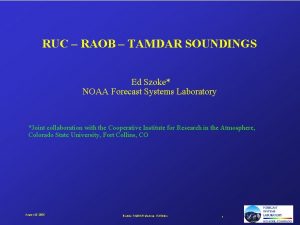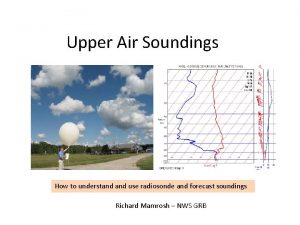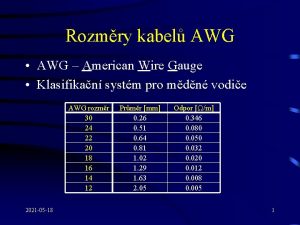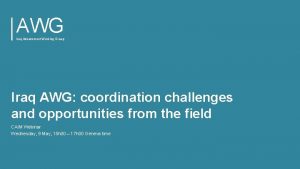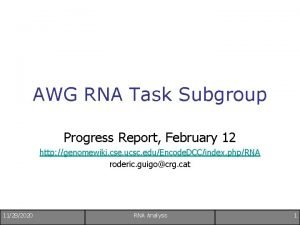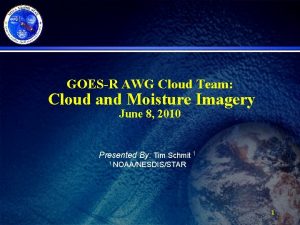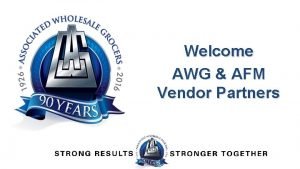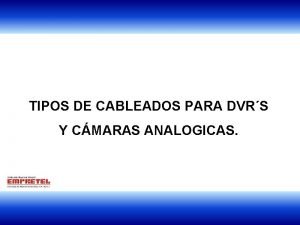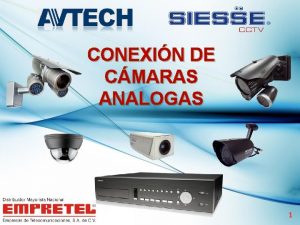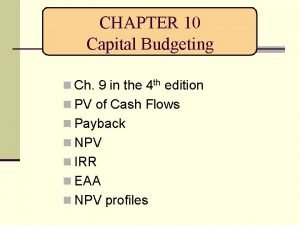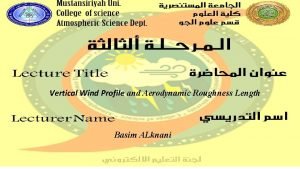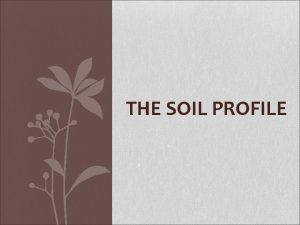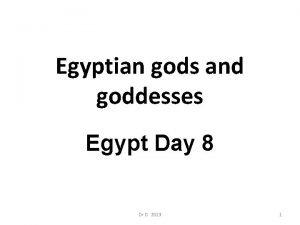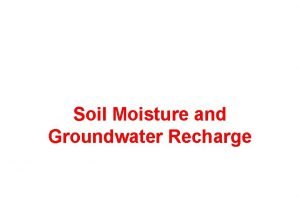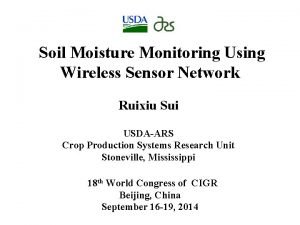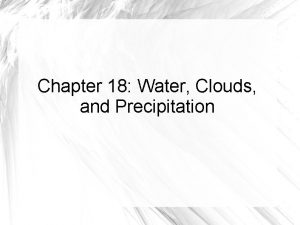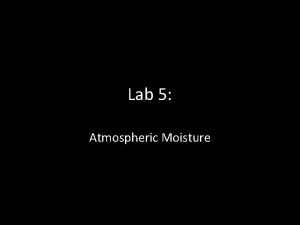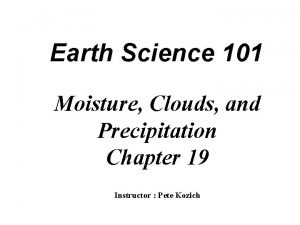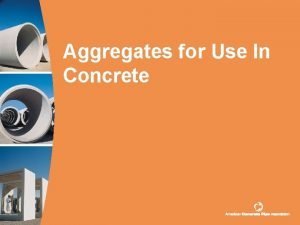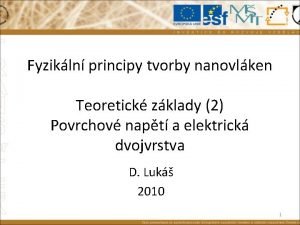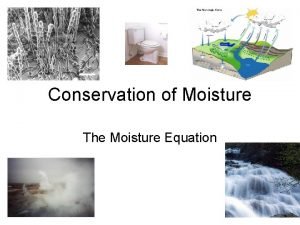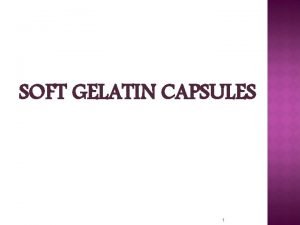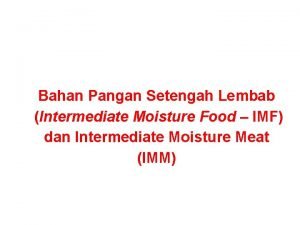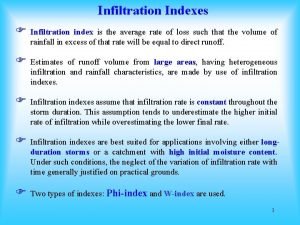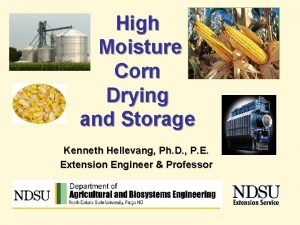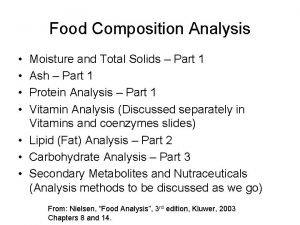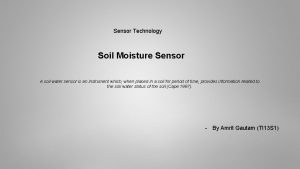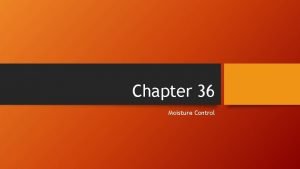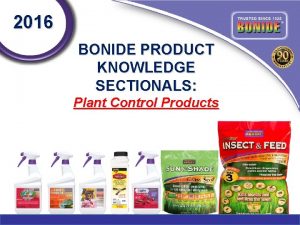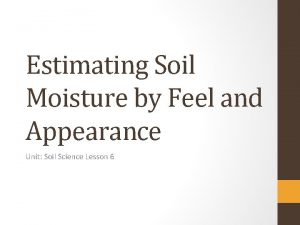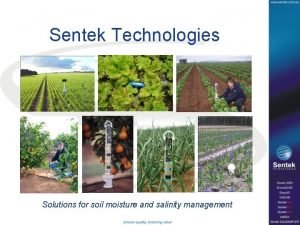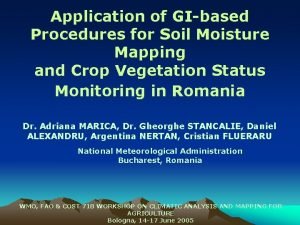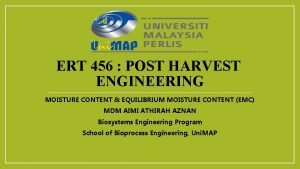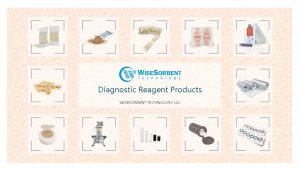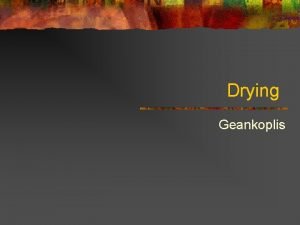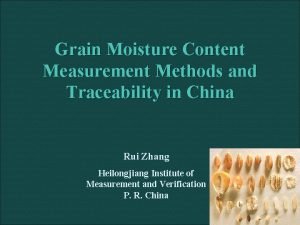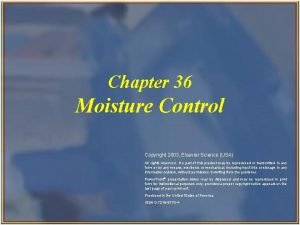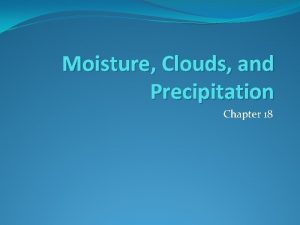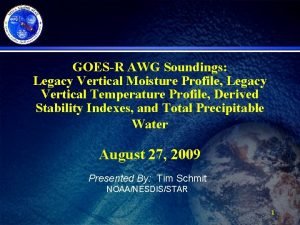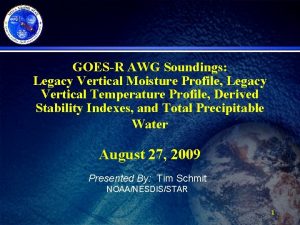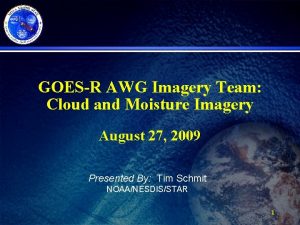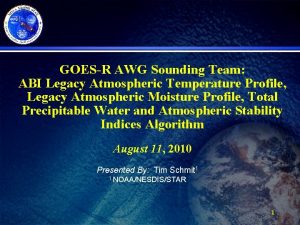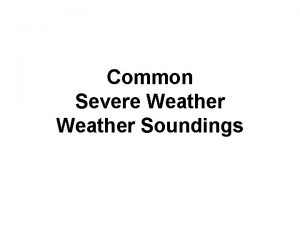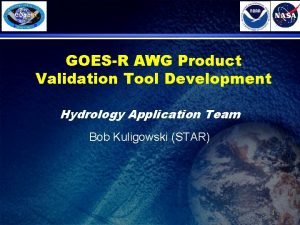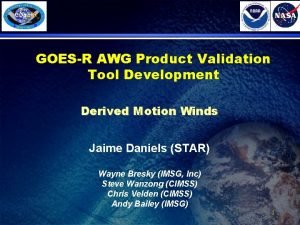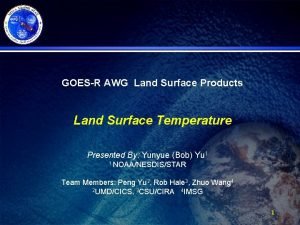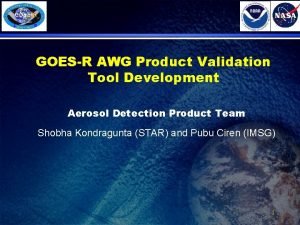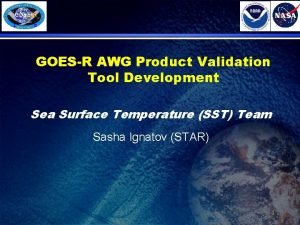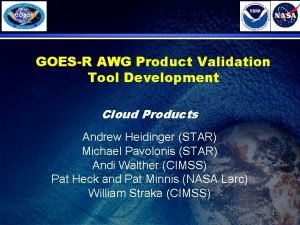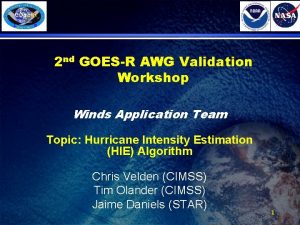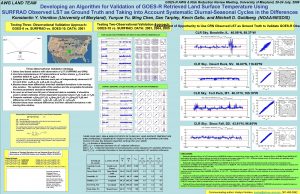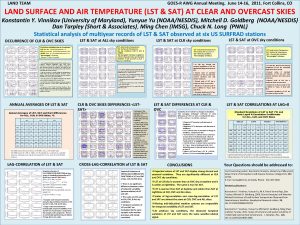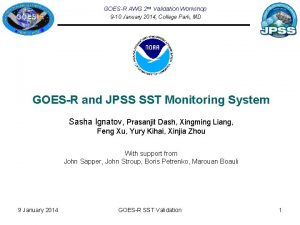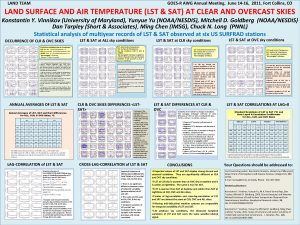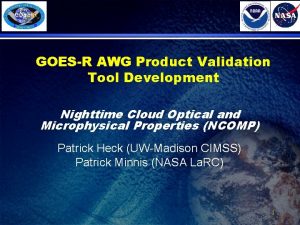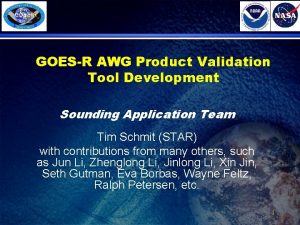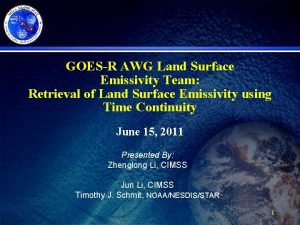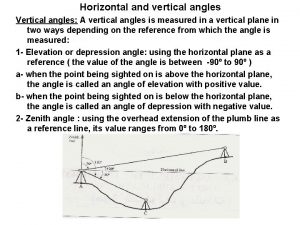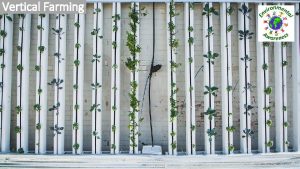GOESR AWG Soundings Legacy Vertical Moisture Profile Legacy









































- Slides: 41

GOES-R AWG Soundings: Legacy Vertical Moisture Profile, Legacy Vertical Temperature Profile, Derived Stability Indexes, and Total Precipitable Water August 27, 2009 Presented By: Tim Schmit NOAA/NESDIS/STAR 1

Outline · · Runoff / Selection Environment Description of Selected Algorithm Validation of Selected Algorithm Summary of IV & V Feedback 2

Requirements – Legacy Vertical Moisture Profile Data Latency Product Measurement Precision Refresh Rate Option (Mode 4) Refresh Rate/Coverag e Time Option (Mode 3) Msmnt. Accuracy Msmnt. Range Mapping Accuracy C – Clear and above Cloud Regions only Reflects layering of Numerical Weather Prediction Models; inherent vertical resolution is only 3 to 5 km 10 km 5 km 0– 100% Sfc-500 mb: 18 % relative humidity & 500 -300 mb: 18% relative humidity & 300 -100 mb: 20% relative humidity 30 min 5 min 266 sec Sfc-500 mb: 18 % relative humidity & 500 -300 mb: 18% relative humidity & 300 -100 mb: 20% relative humidity Legacy Vertical Moisture Profile GOESR FD - Clear and above Cloud Regions only Reflects layering of Numerical Weather Prediction Models; inherent vertical resolution is only 3 to 5 km 10 km 5 km 0– 100% Sfc-500 mb: 18 % relative humidity & 500 -300 mb: 18% relative humidity & 300 -100 mb: 20% relative humidity 60 min 5 min 266 sec Sfc-500 mb: 18 % relative humidity & 500 -300 mb: 18% relative humidity & 300 -100 mb: 20% relative humidity 266 sec GOESR 10 km 5 km 0– 100% Sfc-500 mb: 18 % relative humidity & 500 -300 mb: 18% relative humidity & 300 -100 mb: 20% relative humidity 5 min Legacy Vertical Moisture Profile Sfc-500 mb: 18 % relative humidity & 500 -300 mb: 18% relative humidity & 300 -100 mb: 20% relative humidity Reflects layering of Numerical Weather Prediction Models; inherent vertical resolution is only 3 to 5 km Horiz. Res. GOESR M - Clear and above Cloud Regions only Vertical Res. Geographic Coverage (G, H, C, M) User & Priority Name Legacy Vertical Moisture Profile 3 C – CONUS FD – Full Disk M - Mesoscale

Legacy Vertical Moisture Profile Pending approval, Legacy Vertical Moisture Profile: Product Qualifiers - Remove 'Clear and above cloud regions' from Geographic Coverage parameter. Product Statistics Qualifier Cloud Cover Conditions Qualifier Product Extent Qualifier Temporal Coverage Qualifiers Geographic Coverage (G, H, C, M) User & Priority Name Legacy Vertical Moisture Profile GOES-R C – Clear and above Cloud Regions only Day and night Quantitative out to at least 62 degrees LZA Clear conditions associated with threshold accuracy Over specified geographic area Legacy Vertical Moisture Profile GOES-R FD - Clear and above Cloud Regions only Day and night Quantitative out to at least 62 degrees LZA Clear conditions associated with threshold accuracy Over specified geographic area GOES-R M - Clear and above Cloud Regions only Day and night Quantitative out to at least 62 degrees LZA Clear conditions associated with threshold accuracy Over specified geographic area Legacy Vertical Moisture Profile 4 C – CONUS FD – Full Disk M - Mesoscale

Requirements – Legacy Vertical Pending approval, Legacy Vertical Temperature Profile: Product Measurement Precision Data Latency Refresh Rate Option (Mode 4) Refresh Rate/Coverag e Time Option (Mode 3) Msmnt. Accuracy Msmnt. Range Mapping Accuracy Horiz. Res. Vertical Res. User & Priority GOESR Geographic Coverage (G, H, C, M) Name Legacy Vertical Temperatur e Profile - Change accuracy from '0. 1 K improvement over numerical weather prediction model analysis' to '1 K below 400 h. Pa and above boundary layer' – Change the Precision from '0. 1 K improvement over numerical C – Clear and Reflects layering of Numerical 10 km 5 km 180 – 0. 1 K 30 min 5 min 266 sec 0. 1 K prediction model analysis (TBR)' to '2 K below 400 h. Pa improvement above Cloudweather Weather Prediction Models; 320 K improvement Regions only inherent vertical resolution is over and boundary layer'. onlyabove 3 to 5 km numerical weather prediction model analysis Legacy Vertical Temperatur e Profile GOESR FD - Clear and above Cloud Regions only Reflects layering of Numerical Weather Prediction Models; inherent vertical resolution is only 3 to 5 km GOESR M - Clear and above Cloud Regions only Reflects layering of Numerical Weather Prediction Models; inherent vertical resolution is only 3 to 5 km 10 km 5 km 180 – 320 K 0. 1 K improvement over numerical weather prediction model analysis 60 min 5 min 266 sec 0. 1 K improvement over numerical weather prediction model analysis 5 min 5 C – CONUS FD – Full Disk M - Mesoscale

Legacy Vertical Temperature Profile Pending approval, Legacy Vertical Temperature Profile: Product Qualifiers - Remove 'Clear and above cloud regions' from Geographic Coverage parameter. Product Statistics Qualifier Cloud Cover Conditions Qualifier Product Extent Qualifier Temporal Coverage Qualifiers Geographic Coverage (G, H, C, M) User & Priority Name Legacy Vertical Temperature Profile GOES-R C – Clear and Day and night above Cloud Regions only Quantitative out to at least 62 degrees LZA Clear conditions associated with threshold accuracy Over specified geographic area Legacy Vertical Temperature Profile GOES-R FD - Clear and above Cloud Regions only Day and night Quantitative out to at least 62 degrees LZA Clear conditions associated with threshold accuracy Over specified geographic area M - Clear and above Cloud Day and night Regions only Quantitative out to at least 62 degrees LZA Clear conditions associated with threshold accuracy Over specified geographic area Legacy Vertical Temperature Profile GOES-R 6 C – CONUS FD – Full Disk M - Mesoscale

Requirements – Derived Stability Pending approval, Derived Stability Indices: Indices - Remove the ± qualifier before accuracy value Derived Stability Indices: CAPE, Lifted Index, Kindex, Showalter Index, Totals GOES-R FD N/A 10 km 1 km Lifted Index – 10 to 40 K; CAPE: 0 to 5000 J/kg; Showalter index: > 4 to -10 K; Totals Index: -43 to > 56; K-index: 0 to 40 Lifted Index: +/2. 0 K & CAPE: 1000 J/kg & Showalter inddex: +/- 2 K & Total totals Index: +/- 1 & K index: +/- 2 Lifted Index: +/6. 5 K & CAPE: 2500 J/kg & Showalter index: +/- 6. 5 K & Total totals index: +/- 4 K & K index: +/- 5 K Lifted Index – 10 to 40 K; CAPE: 0 to 5000 J/kg; Showalter index: > 4 to -10 K; Totals Index: -43 to > 56; K-index: 0 to 40 Product Measurement Precision Lifted Index: +/2. 0 K & CAPE: 1000 J/kg & Showalter inddex: +/- 2 K & Total totals Index: +/- 1 & K index: +/- 2 5 min Data Latency Lifted Index – 10 to 40 K; CAPE: 0 to 5000 J/kg; Showalter index: > 4 to -10 K; Totals Index: -43 to > 56; K-index: 0 to 40 30 min Refresh Rate Option (Mode 4) Msmnt. Accuracy 1 km Refresh Rate/Coverage Time Option (Mode 3) Msmnt. Range 4 km Mapping Accuracy N/A Horiz. Res. C M Vertical Res. GOES-R Geographic Coverage (G, H, C, M) Derived Stability Indices: CAPE, Lifted Index, Kindex, Showalter Index, Totals User & Priority Name - Change Horizontal Resolution from 4 km to 10 km. - Remove the '+/-' before Precision values. 159 sec Lifted Index: +/6. 5 K & CAPE: 2500 J/kg & Showalter index: +/- 6. 5 K & Total totals index: +/- 4 K & K index: +/- 5 K 5 min 266 sec 7 C – CONUS FD – Full Disk M - Mesoscale

Derived Stability Indices Products Qualifiers Cloud Cover Conditions Qualifier Product Statistics Qualifier Product Extent Qualifier Temporal Coverage Qualifiers Geographic Coverage (G, H, C, M) GOES-R C Day and night Quantitative out to at least 62 degrees LZA and qualitative beyond Clear conditions associated with threshold accuracy Over specified geographic area Derived Stability Indices: CAPE, Lifted Index, K-index, Showalter Index, Totals GOES-R FD Day and night Quantitative out to at least 62 degrees LZA Clear conditions associated with threshold accuracy Over specified geographic area GOES-R M Day and night Quantitative out to at least 62 degrees LZA Clear conditions associated with threshold accuracy Over specified geographic area Derived Stability Indices: CAPE, Lifted Index, K-index, Showalter Index, Totals User & Priority Name Derived Stability Indices: CAPE, Lifted Index, K-index, Showalter Index, Totals 8 C – CONUS FD – Full Disk M - Mesoscale

Product Measurement Precision 5 min 266 sec 3 mm Total Precipitable Water GOES-R FD - Clear and above Cloud Regions only N/A 10 km 2 km 0 – 100 mm 9% 60 min compared to ground based truth 15 min 806 sec 3 mm 266 sec 3 mm 5 min Data Latency 9% 30 min compared to ground based truth 0 – 100 mm Refresh Rate Option (Mode 4) 0 – 100 mm 9%compared to ground based truth Refresh Rate/Coverage Time Option (Mode 3) 2 km Msmnt. Accuracy 10 km Msmnt. Range N/A Mapping Accuracy C – Clear and above Cloud Regions only GOES-R Horiz. Res. GOES-R M - Clear and above Cloud Regions only Vertical Res. User & Priority Total Precipitable Water Geographic Coverage (G, H, C, M) Name Requirements – Total Precipitable Pending approval, Total Precipitable Water: Water - Change accuracy from '10% compared to ground truth' to 1 mm. 9 C – CONUS FD – Full Disk M - Mesoscale

Total Precipitable Water Products Pending approval, Total Precipitable Water: Qualifiers - Remove 'Clear and above cloud regions' from Geographic Product Statistics Qualifier Cloud Cover Conditions Qualifier Product Extent Qualifier Temporal Coverage Qualifiers Geographic Coverage (G, H, C, M) User & Priority Name Coverage parameter. Total Precipitable GOES-R Water C – Clear and above Cloud Regions only Day and night Quantitative out to at least 62 degrees LZA Clear conditions down to feature of interest associated with threshold accuracy Over specified geographic area Total Precipitable GOES-R Water FD - Clear and above Cloud Regions only Day and night Quantitative out to at least 62 degrees LZA Clear conditions down to feature of associated with threshold accuracy Over specified geographic area Total Precipitable GOES-R Water M - Clear and above Cloud Regions only Day and night Quantitative out to at least 62 degrees LZA Clear conditions down to feature of interest associated with threshold accuracy Over specified geographic area 10 C – CONUS FD – Full Disk M - Mesoscale

Outline · · Runoff / Selection Environment Description of Selected Algorithm Validation of Selected Algorithm Summary of IV & V Feedback 11

Description of Selected Algorithm: Overview ● The two-step algorithm was selected (to balance speed and quality) » Regression for first guess followed by » 1 D variational physical algorithm, which is similar to the current GOES Sounder physical retrieval algorithm 12

Description of LAP Algorithm ● Features of the Selected Legacy Atmospheric Profile Algorithm » » » » » 1 D variational approach Regression as first guess, Regression from combined IR radiances and forecast information Emissivity information from database Surface pressure from forecast EOF representation of profile Forecast error covariance matrix Radiance bias adjustment Excellent historical heritage (e. g. current GOES and MODIS) 13

Description of LAP Algorithm · · Advantages » Low risks » Efficient » Algorithm is mature Disadvantages » Request surface IR emissivity information » Need radiance bias adjustment » Time continuity is not included 14

LAP ADR Algorithm: Key upgrades from the current GOES sounding algorithm for ABI ● Temperature and moisture profiles as well as the surface skin temperature from a regression is used as the first guess in physical retrieval ● Surface IR emissivity from UW baseline fit database (Seemann et al. 2008) ● Use forecast error covariance matrix derived from matchup file in the physical retrieval ● Use model accompanying Jacobian or K-matrix 15

Description of Selected Algorithm: Sensor Input ABI Band Wavelength Range (μm) Central Wavelength (μm) Central Wavenumber (cm-1) sub-satellite IGFOV (km) 1 0. 45 -0. 49 0. 47 21277 1 2 0. 59 -0. 69 0. 64 15625 0. 5 3 0. 846 -0. 885 0. 865 11561 1 4 1. 371 -1. 386 1. 378 7257 2 5 1. 58 -1. 64 1. 61 6211 1 6 2. 225 - 2. 275 2. 25 4444 2 7 3. 80 -4. 00 3. 90 2564 2 LAP (night) 8 5. 77 -6. 6 6. 19 1616 2 LAP 9 6. 75 -7. 15 6. 95 1439 2 LAP 10 7. 24 -7. 44 7. 34 1362 2 LAP 11 8. 3 -8. 7 8. 5 1176 2 LAP 12 13 14 15 9. 42 -9. 8 10. 1 -10. 6 10. 8 -11. 6 11. 8 -12. 8 9. 61 10. 35 11. 2 12. 3 1041 966 893 813 2 2 LAP LAP 16 13. 0 -13. 6 13. 3 752 2 LAP Current Input Sample Use Will be added 16

Description of Selected Algorithm: Processing Outline (Regression) ABI IR Radiances Calibrated, Navigated Radiance averaging Bias adjustment Cloud masking Bias adjusted, Clear ABI Radiances Forecast T/Q profiles Apply regression coefficient First guess (T, Q, O, Ts) Go to physical Module 17

Description of Selected Algorithm: Processing Outline (Physical) Error matrix, EOF file for T(p) and q(p), emiss Start Forward model calculation Regression (T, W, O, Ts) Jacobian calculation Next iteration Input BT, forecast Surface analysis parameters Output Calculate derived products yes No Decrease gamma Return updated T, W, O, Ts Increase gamma Inversion calculation Update profiles (To physical module) yes Fail < fm Check Iteration < Im d. R > d. Rc (Exit physical module) no 18

Assumptions and Limitations · Assumptions » » » The single field-of-view ABI cloud mask is available before the LAP retrieval A high quality dynamic land surface emissivity product is available Forecast temperature, moisture profiles, as well as surface pressure available Ne. DR for all IR bands are reasonably good A fast and accurate radiative transfer model (RTM) along with K-Matrix computation are available, RTM coefficients will be updated when the sensor spectral response functions are available » Algorithm will be calibrated with intensive ground measurements » Forecast error covariance matrix will be updated routinely from matchup file » Retrieval is performed on FOR basis · Limitations » » » LAP is available over “clear” FORs only (more than 10% of clear FOVs within the FOR) Effect of emissivity temporal variation is not handled Surface roughness and skin temperature non-homogeneousness are not handled Since it is an iterative physical retrieval, computation is relative expensive Forecast temperature is hard to improve with ABI 19

GOES-R ABI Weighting Functions ABI has only 1 CO 2 band, so upper-level temperature will 20 be degraded compared to the current sounder

GOES-13 Sounder WFs The GOES-N sounder has 5 CO 2 bands, and more shortwave 21 bands than ABI

The relative vertical information is shown for radiosondes, a high-spectral infrared sounder, the current broad-band GOES Sounder and the ABI. The high-spectral sounder is much improved over the current sounder. This information content 22 analysis does not account for any spatial or temporal differences.

Legacy Atmospheric Profile (LAP) Algorithm Objectives ● Provides state-of-the-art LAP over the GOES-R observation domain, in all ABI scanning modes ● Single time step (day 1) ● Meets the GOES-R mission requirement specified for the LAP products ● Algorithm maturity and LAP heritage ● Computational efficiency ● Improvement potential 23

Runoff / Selection Environment: Candidate Algorithm Selection · Given this is a legacy-type product, no ‘run-off’ per se was generated. Products will be generated to use the available information content of the ABI and be consistent with current GOES Sounder products. · The best components of a number of existing IR retrieval algorithms were combined, leveraging the expertise of the soundings team: » Heritage from current GOES » most recent sounder research version for GOES Sounder » Lessons learned from AIRS processing · Primary criteria were: » Maturity: running in real time » Accuracy: meet specs 24

Outline · · Runoff / Selection Environment Description of Selected Algorithm Validation of Selected Algorithm Summary of IV & V Feedback 25

ABI LAP/DPs Test Plan – Validation: Temperature profiles Comparison of SEVIRI (w/ ABI LAP algorithm) profiles with RAOBs over land ABI/SEVIRI slightly improves the forecast temperature with ABI LAP algorithm due to limited temperature vertical information in ABI/SEVIRI 26

ABI LAP/DPs Test Plan – Validation: Moisture profiles Comparison of SEVIRI (with ABI LAP algorithm) profiles with RAOBs over land ABI/SEVIRI improves the forecast moisture profiles above 600 h. Pa with ABI LAP algorithm 27

ABI LAP/DPs Test Plan – Validation: TPW Comparison of SEVIRI (with ABI LAP algorithm) TPW with RAOBs over land SEVIRI TPW using ABI LAP algorithm agree with RAOB over land, one month (August 2006) matchup (SEVIRI/RAOB) data are used RAOBs 28

ABI LAP/DPs Test Plan – Validation: TPW Comparison of SEVIRI (with ABI LAP algorithm) TPW with AMSR-E product over ocean SEVIRI TPW using ABI LAP algorithm agree with AMSRE over ocean, one month (August 2006) matchup (SEVIRI/AMSR-E) data are used 29

ABI LAP/DPs Test Plan – Validation: Lifted Index Comparison of SEVIRI (with ABI LAP algorithm) LI with RAOBs over land Lifted Index (K) SEVIRI Lifted Index using ABI LAP algorithm agree with RAOB over land, one month (August 2006) matchup (SEVIRI/RAOB) data are used RAOBs 30

ABI LAP/DPs Test Plan – Validation: CAPE Comparison of SEVIRI (with ABI LAP algorithm) CAPE with RAOBs over land SEVIRI CAPE using ABI LAP algorithm over land, one month (August 2006) matchup (SEVIRI/RAOB) data are used RAOBs 31

Outline · · Runoff / Selection Environment Description of Selected Algorithm Validation of Selected Algorithm Summary of IV & V Feedback 32

Summary of IV & V Feedback (A) · Feedback: Accuracy requirement for moisture profile measurement was not accurately reflected by the validation procedure. In particular, Table 1. 2 provided moisture measurement accuracy for three atmospheric layers: sfc-500 mb, 500 mb-300 mb, and 300 mb-100 mb. However, the validation plots for moisture profile showed validation results for atmospheric layers different from those listed. · Response: The WV layers are internal products, but the layering will be made consistent. 33

Summary of IV & V Feedback (A) · · Feedback: The statement on page 16 on the averaging procedure for radiance versus brightness temperature is not accurate. Because of nonlinearity in Planck function, averaging at radiance level should always be recommended. Response: Correct that averaging in radiance is more accurate, especially for the 4 um bands. This will be investigated (e. g. , compared), to see how much a difference it makes for these bands and if the radiance level data are available. 34

Summary of IV & V Feedback (A) · · Feedback: It is not clear how the bias adjustment was done in the retrieval. It would be good to add one more paragraph in the bias adjustment section (Section 3. 2. 4) to describe the satellite radiance bias correction procedure in the retrievals. Response: Agreed, more will be added to the ATBD on the need and methodology of bias corrections. 35

Summary of IV & V Feedback (A) · · Feedback: My major concern with the algorithm is the limited improvement of retrievals over the first guess fields. I recommend reevaluating the possibility of including the Hyper-Spectral Environment Suite or Advanced Baseline Sounder or other …in the GOES-R program. Response: Agreed, an advanced geo sounder is needed to meet the original, validated user requirements. The ABI-only version only meets the ‘relaxed’ requirements to supply products with 36 current sounder-like attributes.

Summary of IV & V Feedback (B) · Feedback (+): » » · The discussion of the effects of the removal of HES is very good, and makes clear the rationale what follows. Given the limited number of channels available, the teams have shown the ability to make significant improvements in the forecast values, especially of water vapor. The work to validate the algorithms, based on data from other instruments, is impressive. The framework is there that explains the outline of the algorithms; a knowledgeable and imaginative person could code the algorithm. Response: Thanks. 37

Summary of IV & V Feedback (B) · Feedback (-): » A moderate amount of editing needs to be done to make the sentences read better, correct syntax errors, and correct typos. Also, a number of paragraphs are not very clear. » There seems to be a certain amount of duplication, where topics covered earlier are returned to in later sections. It’s not clear whether they are trying to say something additional or different. · Response: These types of issues will be addressed for the 100% delivery. 38

Summary of IV & V Feedback (B) · Feedback (details-1): » » » » » p. 11: PSGS not in acronym list p. 12, l. 3: Uses term “Field of Regard”. For an instrument this means the total field that can be viewed. Here it appears to mean the size of a pixel cluster. I would suggest replacing FOR with something like “cluster” or “pixel group”, etc. Table 1 - I found it hard to read with its formatting. A line between the Threshold and Goal columns would help. TBR is not in list of acronyms. Table 1. 2 Lines needed between Temporal Coverage Qualifier and Product Extent Qualifier and Cloud Cover Conditions Qualifier. p. 16, l. 2: Td 850 not defined SI: Definition not clear. Definitions have gone from using T 500 to T 500 p. 17 (and many other places)- explain [6 -18 hours] forecast- is this a particular forecast (averaged over this period), the same forecast that can be used, as necessary, anytime within that time period, or ? ? L RTM? p. 20, Sec. 3. 1. 1: Why are both calibrated radiances and BT’s needed, since it has been pointed out that they are equivalent. p. 21, Static data: where are the training datasets for temperature and water vapor profile described; also the lookup table for ABI IR emissivities over the ocean. 3. 2. 1: It is only necessary that the vertical profile of CO 2 be known, not that it be uniformly mixed. The description of the retrieval should be rewritten for clarity. Although Rodgers (1976) is mentioned, (why not his book, Rodgers 2000? ), it appears the method is not an optimal estimation, but makes use of a form of Tikhonov regularization. p. 25, bottom para. : is nsamps = number of profiles? p. 26: Bottom paragraph is unclear. p. 27, top line: What is reference for statement that regularization is “more mathematically solid”? p. 28: Explain J’ & J”. What are the derivatives with respect to. These appear to be merely to illustrate Newtonian iteration- is that right. It would be more convenient to move the definition of F’ up closer to its first use. » Response: Each of these questions will be addressed 39 for the 100% delivery.

Summary of IV & V Feedback (B) · Feedback (details-2): » » » » » · p. 35: What are d, s and d? p. 36: How and where in the process is the SO 2 flag set? p. 39: Top paragraph: Do the bias adjustments need to be checked and updated over time? How frequently? 4. 1. 5. 2 Clarify- Regression coefficients for First Guess Retrievals p. 40, 4. 1. 5. 3: Errors for T, q and Ts assumed to be uncorrelated, but can’t this be tested based on the data described in the previous section? It seems plausible that the water vapor and its errors would be larger for higher temperatures. Temperature error correlation-is there no distinction between land ocean? Can equivalence of NH and SH be tested? p. 41, Sec. 4. 1. 5. 4: errors in radiance channel measurements usually assumed to be uncorrelated with other channels, but this is testable on the ground. p. 42 top- what is 0. 1 K error in forward model based on? 4. 1. 5. 5 - Where is the global training set described? Is this the same one used to derive the regression coefficients? p. 43, top ¶ 3 water channels + 2 with additional BL information => 3 EOF’s- more not possible? p. 46, Sec. 4. 2 - What are non-linear regression files? Should RTTOV be just RTM? p. 48, Sec. 5. 1 - what is “…every slot. ”? Sec. 5. 3, (5)- Make clear someplace that the RTM’s are regression-based. Somewhere state how often these need to be updated to accommodate increase in atmospheric CO 2. p. 50, Sec. 6. 1 - This is first mention of regression ozone- this should be spelled out. Sec. 6. 1. 2. 2 ALS not in acronym list. p. 51, Sec. 6. 1. 2. 5 needs to be made clearer. p. 52: F & PS not in acronym list. p. 53, discussion of Fig. 14 - what is forecast error? Pp 56 ff: The improvement in LI, SI, TT, K and CAPE over forecast values should be given. Response: Each of these questions will be addressed for the 100% delivery. 40

Open Discussion · The time is now open for discussion 41
 Ruc soundings
Ruc soundings Upper air soundings
Upper air soundings Awg tabulka
Awg tabulka Awg
Awg Awg aken
Awg aken Awg cloud
Awg cloud Awg warehouse locations
Awg warehouse locations Awg vendor portal
Awg vendor portal Tabla de awg amperaje
Tabla de awg amperaje Cable 18 awg amperaje
Cable 18 awg amperaje Salinity vertical profile
Salinity vertical profile Project alpha's npv profile crosses the vertical
Project alpha's npv profile crosses the vertical Vertical wind profile
Vertical wind profile A horizon
A horizon Orsis god
Orsis god A capillary tube
A capillary tube Soil moisture sensor
Soil moisture sensor Love of cloud and rain chapter 18
Love of cloud and rain chapter 18 Lab 5 atmospheric moisture
Lab 5 atmospheric moisture Moisture clouds and precipitation
Moisture clouds and precipitation Moisture holding capacity
Moisture holding capacity Chapman flask moisture chart
Chapman flask moisture chart Dimensional formula of surface tension
Dimensional formula of surface tension Moisture equation
Moisture equation Definition of hard gelatin capsule
Definition of hard gelatin capsule Shea moisture revenue
Shea moisture revenue Intermediate moisture food
Intermediate moisture food Infiltration indices
Infiltration indices High moisture corn storage
High moisture corn storage Moisture and total solids analysis
Moisture and total solids analysis Resistive soil moisture sensor working principle
Resistive soil moisture sensor working principle Chapter 36 moisture control short answers
Chapter 36 moisture control short answers Bonide leaf shine and moisture guard
Bonide leaf shine and moisture guard Estimating soil moisture by feel and appearance
Estimating soil moisture by feel and appearance Sentek soil moisture
Sentek soil moisture Moisture mapping software
Moisture mapping software Equilibrium moisture content definition
Equilibrium moisture content definition Wisesorbent technology llc
Wisesorbent technology llc Free moisture content
Free moisture content Grain moisture content measurement
Grain moisture content measurement Chapter 36 moisture control
Chapter 36 moisture control In order for clouds to form cooling air must be
In order for clouds to form cooling air must be
